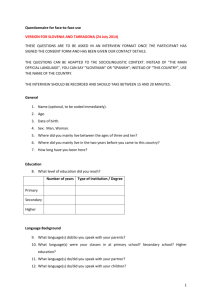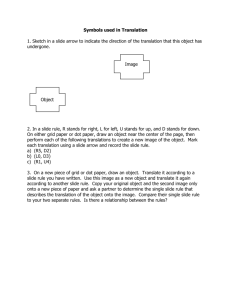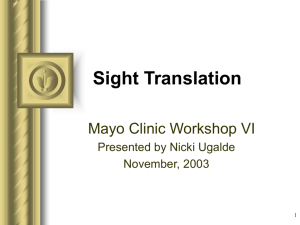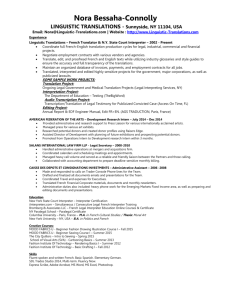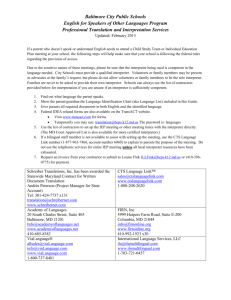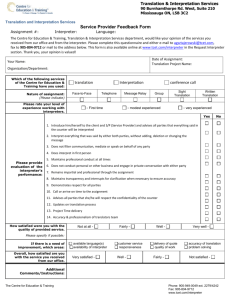(MS PPT) TRIN 3102 Week 3
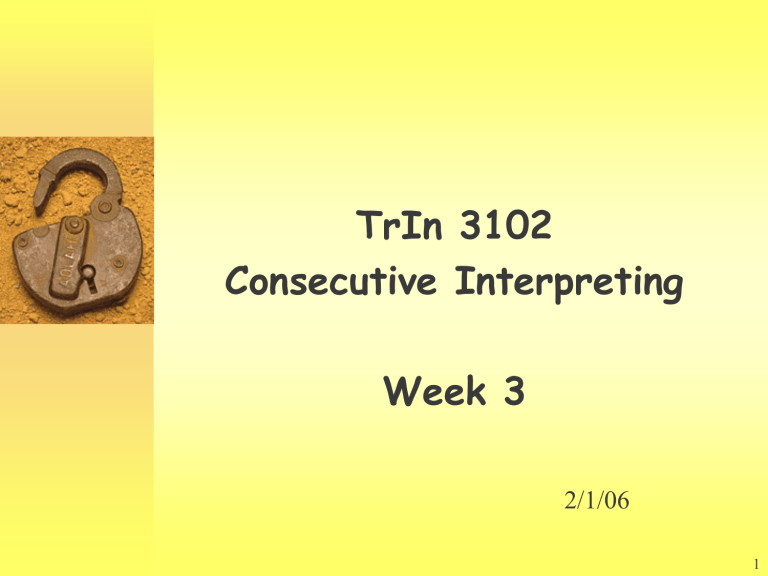
TrIn 3102
Consecutive Interpreting
Week 3
2/1/06
1
Class agenda: Lecture
1. Turn in 1 thought question
2. Identify purpose of note-taking within the interpreting process
3. Describe other strategies for increasing STM capacity
4. Identify the type of information for which note-taking is most often used (proper nouns, numbers)
5. Define sight translation and identify settings used
6. Identify strategies in preparing for and interpreting a sight translation
7. Assignment: Four articles to read (see syllabus) and Situation #1
2
Definition: Note-taking
The act of taking information, processing it, prioritizing it and then interpreting it meaningfully in writing so that it will be helpful later.
3
Purpose of Note-taking
To supplement and aid memory efficiently
To facilitate retention and recall (short-term memory)
To assure accuracy of the message
To remember proper nouns, exact dates, numbers, technical terms
To increase the number of chunks (key words/ideas) and the quantity of information
(such as details) included in each chunk
Lab page 1: Shorthand Hints for Note- taking
4
Note-taking as a Strategy for Increasing Short Term
Memory Capacity
1. The average person’s memory is more than adequate for consecutive interpreting; the main problem is listening skills.
2. Learn to shut out all distractions and focus all of your attention on the message that is to be interpreted.
3. Prediction: Develop an interest in the subject matter; learn background information to help you better understand what the patient/clients and professionals are talking about.
4. Visualize a story, mentally or with pictures or symbols.
5. Chunking: Write down a list of key words, one for each idea.
6. Identify the type of message to be interpreted:
– a list of symptoms would lend itself more towards note-taking rather than on your visual memory
– Telling a step-by-step story lends itself more towards visual graphics
5
When to take notes
Speed of delivery: Taking notes during a very rapid presentation may interfere with listening, while at slower speeds, it may enhance listening by increasing the concentration.
Efficiency of note-taking: the fewer notes taken, the better the recall
Very few words of the original message are written down, because it is necessary to focus on ideas, not words. It is all too easy to become absorbed in the notes themselves, and forget to attend the message as it is being offered by the source language speaker. If interpreters do not look at the speaker, they miss valuable non-verbal cues. Notes are only a mnemonic aid.
Key words and symbols are meaningful only to the interpreter using them.
6
Techniques
Placement of ideas
Abbreviations
Symbols
Lines
Pictures and diagrams
7
Placement of ideas
Indentation: keep subordinate ideas to the left with key ideas on the right of the page
Verticalization: verticality of lists; establish a logical progression of ideas starting at the top of the page
Your example:
8
Abbreviations
Common abbreviations: W- west or
Wed.
Affixes: pre-, post-
Verb tenses: -ed
Scientific abbreviations: H
2
O (water),
Fe (iron)
Shorthand notations: Q (question)
Acronyms: IBM, M.D., ETA
Shortened words: est., pro, b4, thru
9
Symbols
Mathematical and scientific symbols: ! # % + ± =
< >
Greek letters:
&
Arrows:
Punctuation marks: ! ? ~ : “ “
Your own:
10
Lines
Negation: - + Ø
Relationship: //
Repetition: dittoes
Numbers: IV, XXI
Circles: @ ©
Underlining for emphasis
11
What to do with those notes after the assignment?
Save your notes.
Immediately after the assignment, try to recall and restate as much of the information interpreted-based on your notes-as you can. Do the same a week later.
Keep a list of those symbols, abbreviations, key words, etc., that consistently work best for you to help your STM.
12
Sight Translation
Definition: oral translation of a written text
Sight translation is just as difficult as simultaneous interpretation and involves some of the same mental processes. The input is visual (written word) rather than oral (spoken word), but the interpreter still has to process a thought in the source language and generate the target language version of that thought while simultaneously processing the next source language thought, etc. Because the message is written in black and white, some interpreters may have more trouble focusing on meaning rather than words.
13
Elements of Sight Translation
1. Conservation: the interpreter should conserve the register of the source language text
(complex vs. simple, formal vs. informal)
2. Written language:
– Written material is more densely packed with information than spoken language.
– Punctuation may serve the function of intonation.
14
Elements
3. Reading Comprehension: Interpreters must be adept at grasping the meaning of written texts and understanding the material explicitly and implicitly (interrelationships of ideas)
4. Prediction: Interpreters should be able to predict the outcome of an incomplete message and also be versed in the various writing styles such as legal documents, personal and business correspondence, technical reports so they can be alert to common constructions that may pose translation problems.
15
As students train, they . . .
Learn how to conduct themselves in front of an audience.
Acquire the basic reflexes required to transpose a message into another language.
Develop a swift eye-brain-voice coordination.
Analyze faster a message presented visually rather than orally.
16
Skills required for sight translation
Complete command of working languages at all levels of usage
Good public speaking: voice projection, clear enunciation, good posture and smooth pacing
Mental agility and flexibility in order to work on two channels at once
(simultaneously processing the source language while speaking in the target language)
17
Settings for Sight Translation
List the types of forms and documents that may need to be sight translated in the following settings…….
– Hospitals/Clinics: medical reports, waivers, consent forms
– Court documents: waivers, probation and police reports, documents of a case file, affidavits
– Public/private schools: records, IEP
– Adoption agencies: birth/death/marriage certificates
– Workforce: forms, reports
Other:
18
Process of Sight Translation
1.
2.
3.
4.
5.
Scan the document to determine the subject matter, context, style, and country of origin.
Make a mental note of common pitfalls unique to the source language.
Skim the passages quickly and identify key features, commas, parentheses, etc.
Translate sentence by sentence, focusing on one unit of meaning at a time.
Maintain a steady pace, translating as smoothly as possible.
19
Let’s try it . . .
Using the suggestions on the last slide, your classmate will informally sight translate slide 13 and you will translate slide
21. Where did you hesitate? Why?
20
Strategies for Interpreting a Sight
Translation
READING COMPREHENSION: is an important element of sight translation. Interpreters should read as much and as widely as possible.
PACING: The interpreter must translate the document quickly, without omitting anything. Going too fast results in translation error or in sudden stops and long pauses while the interpreter figures out a difficult translation problem. That sort of jerkiness can be distracting to the listener. But going too slowly is disruptive for providers and patients alike. The interpreter should be familiar with the terminology and phrasing of medical/court documents so that the translation sounds as if the interpreter were merely reading a document written in the target language.
21
Strategies
Translate as smoothly as possible.
Look up and keep a glossary of any difficult terms.
Practice out loud always, with or without an audience.
Record yourself on audio (or videotape) so that you know how you sound (and look) to your audience.
Practice with a variety of type faces and formats: patient information forms, consent forms, letters, consumer education documents, court transcripts .
. .
Other strategies?
22
Lab Exercise #1: Role Play
(optional videotape)
[Act out your prepared role play questions]
– Identify the setting and the English- speaking professional involved.
– List and type 10 questions that could be asked in this setting.
– Have the questions listed in a logical order for them to be asked.
– Make a copy for the professional and the instructor.
– Prepare yourself to be the client/patient for the role-play.
23
Questions to answer while observing each role-play assignment
• 1. How are the parties addressed (formally or informally)?
• 2. Is the interpreter prepared?
• 3. Which inappropriate roles were noted?
• 4. Was there awareness of cultural dimensions?
• 5. Did the interpreter ask for clarification and pauses when needed?
• 6. Did the interpreter use eye contact and the first person in addressing the parties?
• 7. Was the message preserved?
• 8. Is the message loud enough?
• 9. Is the interpreter
’ s speech clear and well-pronounced?
• 10. Does the interpreter
’ s intonation pattern convey the same impact as that of the original speaker?
• 11. Does the interpreter react to the message or the participants?
24
Lab Exercise 2 (Note-taking)
Pair activity: Listen to the directions given by the English speaker on video.
After each pause, one of the pair will take notes in English and the other in Spanish.
Both will vocally reproduce on tape the message in Spanish based on the notes.
Listen to both taped renditions and fill out the five-step follow-up sheet for each person. Attach the completed follow-up to the English script and turn in to the instructor.
25
Sight Translation Exercise 1
(to be audiotaped)
(p. 142) Accidente de tráfico [Spanish
(source) to English (target)]
Record your sight translation onto your audiotape for 3 minutes only.
As you listen to your own tape, highlight or underline those words and phrases you feel could have been interpreted more clearly.
Make a list of possible terms/vocabulary that might work better to transmit the message.
You may choose to compare your work with a classmate.
26
Sight Translation Exercise 2
(to be audiotaped)
English to Spanish or Spanish to English
(pp. 141, 143, 11-15)
Each pair of students will be given a different document to sight translate.
Individually, each student will record the translation for 3 minutes only.
When finished, together each pair will listen to the other’s taped translation and compare notes. Simply note the similarities and differences in vocabulary and terms used; do not analyze errors or determine accuracy.
27
Week 4 Assignment
Read “ Ethical Dilemmas”, “Code of Ethics for
Interpreters”, “Code of Ethics for Educational
Interpreters”, “Educational Interpreters”
– Write 4 thought questions to share.
Prepare Interpreting Situation #1: Type a long paragraph describing an ethical situation (real or fictitious) related to interpreting. Itemize your options to resolve it, list the consequences of each resolution and your ultimate choice with accompanying rationale.
Please bring your videotape also for the next three (3) weeks (Feb. 8, 15, 22)
Keep smiling!
28


